At one point, I was researching those mysterious salamander pets because I wanted one and came up with the idea that I should get it some companions.

Unfortunately, it turned out it’s not as simple as tossing a goldfish in the tank because the fish that can live with an axolotl need to meet some strict criteria.
Axolotls are bottom dwellers that inhabit cold water rich in minerals, with little to no flow.
On top of that, these animals will try to eat almost anything that moves – most of the time successfully.
The ideal tank mates for an axolotl are fish that thrive in the cold and dwell near the water’s surface. These fish should also be pretty agile while keeping to themselves, not harassing your axolotl. Very few species check all the marks but some that do are killifish from the Fundulus genus. These include species such as the Golden Topminnow and the Blackstripe Topminnow.
And before we move on to the list, know this – there’s always a chance that the axolotl or its tank mates will cause each other trouble.
9 fish that can reside with an axolotl as its tank mates

Although the focus of this article is my research on the fish tank mates for an axolotl, I will first discuss if multiple axolotls can live together.
These unique-looking creatures are very independent and will not get lonely if kept on their own. It is generally encouraged to keep one axolotl at a time.
However, you can have more than one in the same take, if they are given adequate space of about 20 gallons each while being similar in size.
If they are not the same size the larger axolotl will try to get a bite from the smaller one.
That being said, here are the 9 fish that can live with an axolotl and are perfect as its tank mates:
1. Blackspotted Topminnow – Fundulus Olivaceus
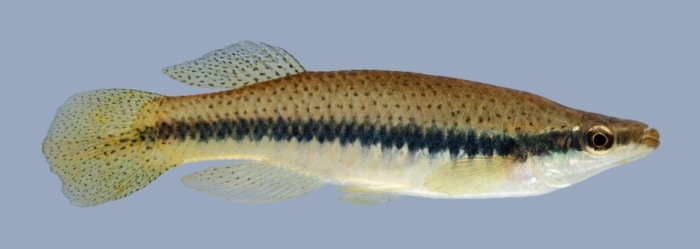
by Uland Thomas
- Potential for long-term success: 9/10
- Maximum adult size: 2.5 in (6.35 cm)
- Key traits: Fast, calm, schooling fish
The Blackspotted Topminnow is a great choice if you’re looking for a compatible addition to your axolotl aquarium.
Axolotls are naturally predatory to fish that are smaller than them, so it’s a good idea to pick a species that is quick enough to escape in case they get targeted.
For Blackspotted Tominnows to properly share a habitat with an axolotl, they need about 30 inches of horizontal length in the tank.
A 20-gallon “Long” tank provides enough room for them to create their natural schooling groups.
Blackspotted Topminnows also enjoy quiet waters with little flow, which aligns with what axolotls like. Fundulus Olivaceus also prefers water with a temperature of 15 to 25°C (59 to 68°F) which is also ideal for an axolotl aquarium.
And finally, what makes this fish a fantastic tank mate for an axolotl is its preference to dwell near the water’s surface.
2. White Cloud Mountain Minnow – Tanichthys Albonubes

by fifteenlostkeys
- Potential for long-term success: 7/10
- Maximum adult size: 1.4 in (3.6 cm)
- Key traits: Cold water tolerant, peaceful, active
Tanichthys Albonubes, more commonly known as the White Cloud Mountain Minnow is in my opinion another great option for suitable axolotl tank mates.
These fish are fast swimmers, prefer cold water, and spend the majority of their time in the middle or upper sections of their tank.
The White Cloud Mountain Minnow is also pretty small and only needs a 10-gallon tank with 5 to 6 other members to form a school. On top of all of that, they are also friendly and will not annoy or disturb your axolotl.
All of these qualities combined make the White Cloud Mountain Minnow species a high contender for a fish that can safely live together with an axolotl. For more information on coldwater fish that are not necessarily ideal for an axolotl tank, visit this article.
3. Lined Topminnow – Fundulus Lineolatus

by Uland Thomas
- Potential for long-term success: 8.5/10
- Maximum adult size: 1.5 in (3.8 cm)
- Key traits: Peaceful, shy, cold water tolerant
This temperate and hardy little fish is not the most popular amongst aquarists.
However, the Lined Topminnow is ideal to put in a tank with an axolotl if you are looking for good stocking ideas.
Fundulus Lineolatus is pretty tiny but they need more tank room since you’ll be housing multiple specimens together.
Lined Topminnows are fairly shy so having foliage and plants near the water surface where they could hide in is a good idea.
Also, you won’t have to worry about them disturbing other underwater residents like your axolotl.
Lined Topminnows will do fine within the water temperature range of axolotls, and dwell near the aquarium’s surface.
These traits make them an ideal pairing with your pet axolotl.
4. Celestial Pearl Danio – Danio Margaritatus

by OoglyBoogly
- Potential for long-term success: 6.5/10
- Maximum adult size: 1 in (2.5 cm)
- Key traits: Schooling fish, cold water tolerant, small, timid
The Celestial Pearl Danio, also known as Danio Margaritatus, is a beautiful little fish that has a timid personality.
To make them more comfortable, include a lot of plants in the setup to provide plenty of places for them to hide.
Just like the axolotl, the Pearl Danio likes cooler, slow-moving water because they are temperate fish.
Celestial Pearl danios are also a schooling type of fish, so keep at least 6 together at a time to help them feel safer in the aquarium. Their water preferences make them good tank mates for the axolotl, but their lower dwelling position and size may put a target on their backs.
Want to discover different axolotl morphs? Explore colorful options in this article.
5. Clown Killifish – Epiplatys Annulatus
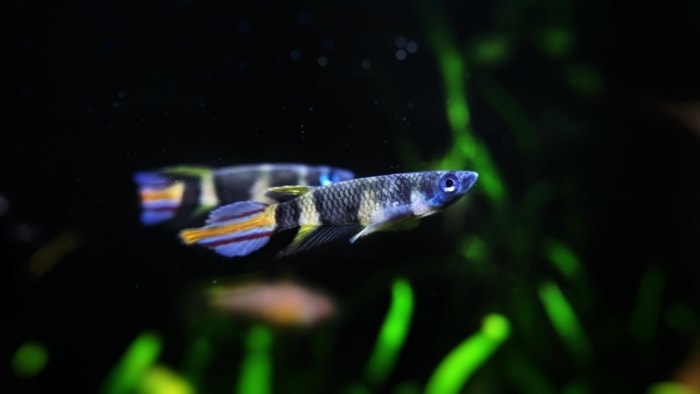
by rockland211
- Potential for long-term success: 7.5/10
- Maximum adult size: 1.4 in (3.6 cm)
- Key traits: Peaceful, uniquely colored, displays better colors when kept in groups, jumpers
The Clown killifish is a colorful freshwater fish that is not only fun to look at but interesting to watch as well. They spend a lot of time dwelling at the top of their tanks and it’s best to keep them in small groups of 5 or so.
The Clown Killifish, coming from the Epiplatys genus, is not typically a beginner-friendly fish.
It requires still water with little to no movement and is sensitive to changes in its environment. While the Clown Killifish may meet a lot of requirements to be housed with axolotls, they aren’t the easiest fish to look after.
Author’s note: This type of killifish has a uniquely-shaped tail that looks like a rocket blasting off which is a cool characteristic that I am very fond of.
6. Mummichog – Fundulus Heteroclitus
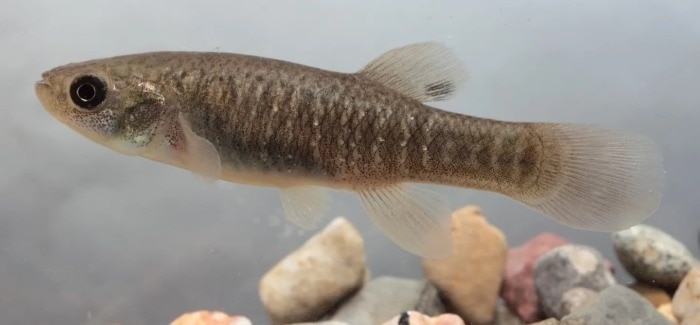
by Guest_taoyeah_*
- Potential for long-term success: 9/10
- Maximum adult size: 5 in (12.7 cm) but usually stays around 3.5 inches (8.9 cm)
- Key traits: Thrives in brackish waters, tolerates cooler water when kept in freshwater, very hardy overall
The Mummichog fish, otherwise known as Fundulus Heteroclitus, is a relatively larger fish with a boisterous personality.
Its temperament could potentially become a problem for its calmer tank mates if Mummichogs begin to pester them.
Its preferences for hard water and cooler temperatures make it a good candidate for an axolotl tank. They typically thrive in brackish waters but salinity is not necessary for them to do well in your aquarium.
Moreover, they tend to tolerate even lower temperatures when kept in freshwater, which is more than welcome in an axolotl tank. However, the Mummichog’s active personality may cause problems if it starts to enter spaces where it’s unwanted.
Having a larger tank of about 40 gallons will allow each aquatic resident to have their own space while leaving enough room for Mummichogs to school as well.
Also, they are fairly hardy, so if you are looking for a fish that is easier to care for, this one is maybe for you.
Thinking of adding an axolotl to your tank? Check out various colorful morphs available here.
7. Golden Topminnow – Fundulus Chrysotus
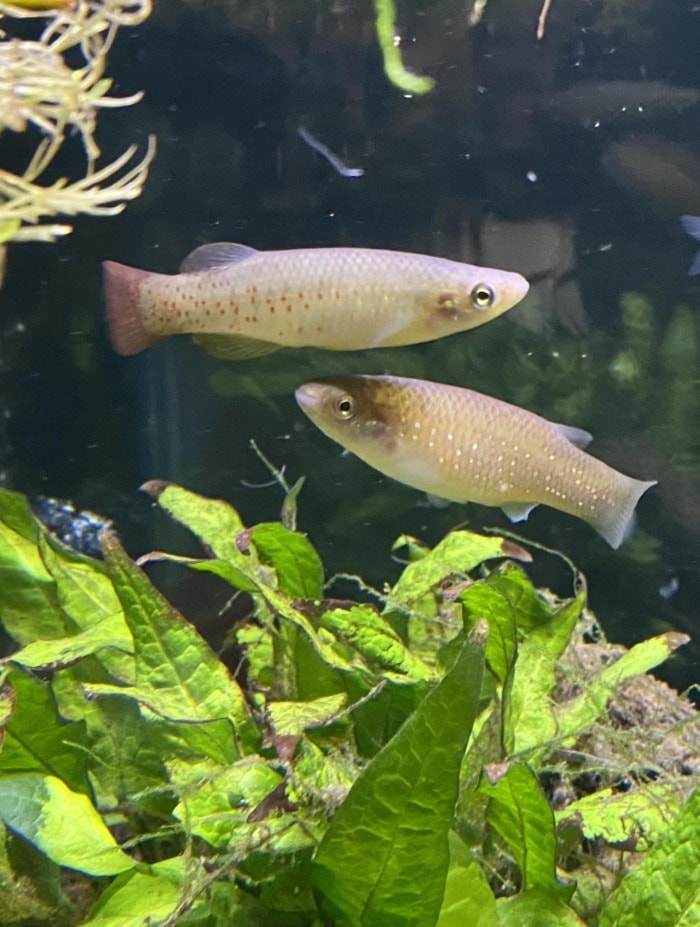
by 1uninterested
- Potential for long-term success: 9/10
- Maximum adult size: 2.5 in (6.5 cm)
- Key traits: Will eat aquarium pests, live in schools, peaceful
Golden Topminnows are peaceful little guys that choose to spend the majority of their time dwelling at the surface of the tank, eating algae and any insect pests that appear.
Fundulus Chrysotus also needs to be housed in a tank that is at least 20 to 30 gallons to comfortably accommodate a group of 4 of them.
The Golden Topminnow’s natural desire to swim at the surface of the tank makes them a good companion for the bottom-dwelling axolotl.
If you look them up you’ll notice that they do prefer warmer waters due to their natural habitats being in places like South Carolina and Texas.
However, what not many people know is that the Golden Topminnows have a very strong tolerance for colder temperatures and they do not bother them in general. Luckily, these fish are easily available in the aquarium trade and you can get them from multiple stores such as here (Wild Fish Tanks) and here (Imperial Tropicals).
8. Black stripe Topminnow – Fundulus Notatus
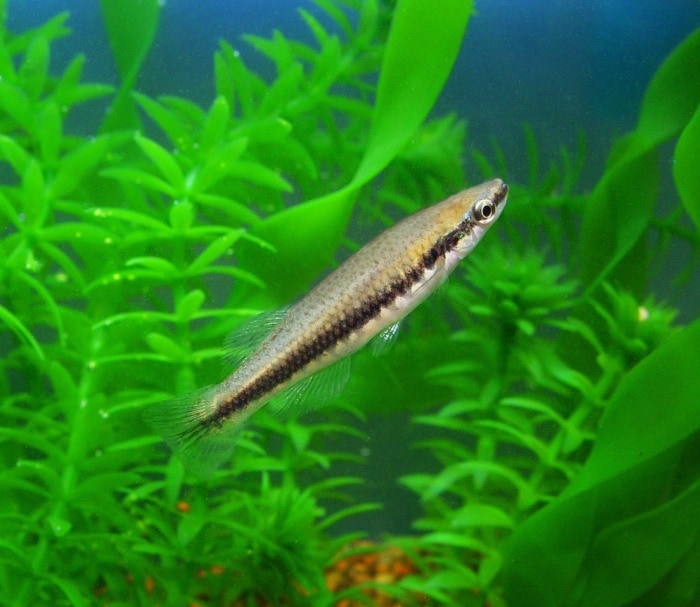
by Konrad Schmidt
- Potential for long-term success: 9/10
- Maximum adult size: 3.5 in (8.9 cm)
- Key traits: Surface dwellers, schooling fish, prefer cold and slow water
Yet another axolotl tank mate option from the Fundulus genus – Fundulus Notatus, but more commonly known as the Black Stripe Topminnow.
These temperate fish tend to dwell at the surface of the water to get more oxygen intake in low-oxygen waters.
The natural environment of this fish typically involves slower, cooler water from ponds formed by upland streams.
They typically don’t tend to cause trouble in the aquarium unless they are competing for female attention.
If there will be any aggression coming from the Black Stripe Topminnow it will remain among them.
Anyhow, their diet is mainly carnivorous because they primarily rely on the bugs that land on the surface of the water.
Keep this in mind when deciding on what food to provide them.
9. Golden Wonder Killifish – Aplocheilus Lineatus
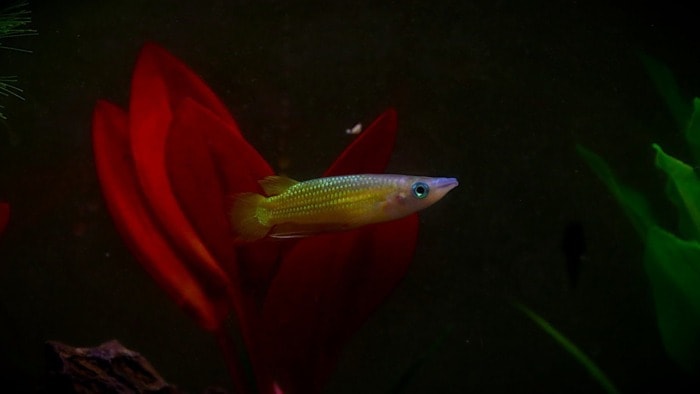
by ChrissFishes01
- Potential for long-term success: 8.5/10
- Maximum adult size: 4 in (10 cm)
- Key traits: Hardy, predatory with large appetite, jumpers
The Golden Wonder Killifish (Aplocheilus Lineatus) is a hardy fish that is suitable for beginners and needs a tank of about 20 gallons to live peacefully with its tank mates.
This adaptive fish seems to be comfortable in brackish aquariums, but it has no problem living in freshwater. It also has no issues adjusting to lower water temperatures, being a killifish.
Keep in mind that Golden Wonder Killifish can be aggressive to other fish that are smaller than them.
Either way, they tick the checkboxes of a lot of the requirements needed to be housed with axolotls, but I think other options will be easier if you are a beginner in the aquarium hobby.
Author’s note: Golden Wonder Killifish tend to jump out sometimes, so make sure to keep a tight lid on the top of your aquarium.
Fish that you should never put in an axolotl tank
There are some fish species that just won’t lead a good life in an axolotl tank and should therefore never be put in one.
These fish will either get eaten instantly, suffer metabolism issues from the cold water or harm your axolotl.
1. Bettas and other tropical fish
Tropical water fish like mollies and betta fish typically dwell in warmer climates and are suited to do so.
Axolotls need to be kept in cold waters, so if you choose to house an axolotl with a tropical fish, one of them may become sick and in the worst-case scenario, die.
Some examples of popular tropical aquarium fish that should not be kept alongside axolotls are:
- Bettas
- Discus
- Angelfish
- Mollies
- Neon tetras
- Dwarf rasboras
2. Goldfish and other fish with long fins
While goldfish like cold water and might seem like a good stocking idea for an axolotl aquarium, they have a few qualities that make them a bad choice.
Goldfish have been known to nip at and bother other tank mates, and they may do the same to your axolotl.
On the other hand, smaller goldfish species may lose a fin or two when the salamander gets hungry.
Plus, this type of fish tends to take up more space and may have sharp or venomous fins that can harm or kill your axolotl.
Here are a couple of examples of popular slow swimmers with long fins:
- Goldfish
- Guppies
- Swordtails
- Betta fish
- Long-fin breeds of danios, minnows, and barbs
3. Plecos and other bottom-dwelling fish
All fish listed below are bottom-dwelling fish, which means that they would be in direct competition with axolotls for food.
On top of that, these fish are at risk of losing a body part when the nearly-blind axolotl decides it’s time for dinner. If you want to include some fish with your axolotl, pick ones that stay away from the bottom level of the tank.
- Plecos
- Loaches
- Corydoras catfish
- Red Tail and Rainbow sharks
4. Cichlids and other overly aggressive fish
Aggressive fish like large Cichlids and Oscars are a very poor choice of a roommate when an axolotl is involved.
These fish are quite territorial and will not hesitate to fight if they feel like their space is invaded.
The same thing goes for axolotls.
It’s not just fish that can’t be housed with axolotls, other creatures with a strong bite like aquatic turtles don’t share space well either.
They dwell on the bottom of the tank and require different temperatures, both things that would cause a problem with axolotls.
The following aggressive fish don’t make good tank mates for axolotls:
- Most Barbs
- Gouramis
- Cichlids
- Puffer fish
- Oscars
- Angelfish
Closing thoughts
Hopefully, this list gives you a better idea of what fish you can use to create a peaceful and interesting community to accompany your axolotl.
It’s not your typical selection as most of them are native to North America, but in my research, these turn out to be your best bet.




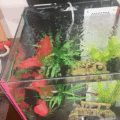
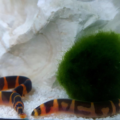
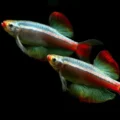



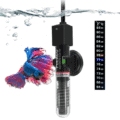
Love this post! Exactly what I was needing. Now if only there were links or places to find these amazing fish. So far searches are not fruitful.